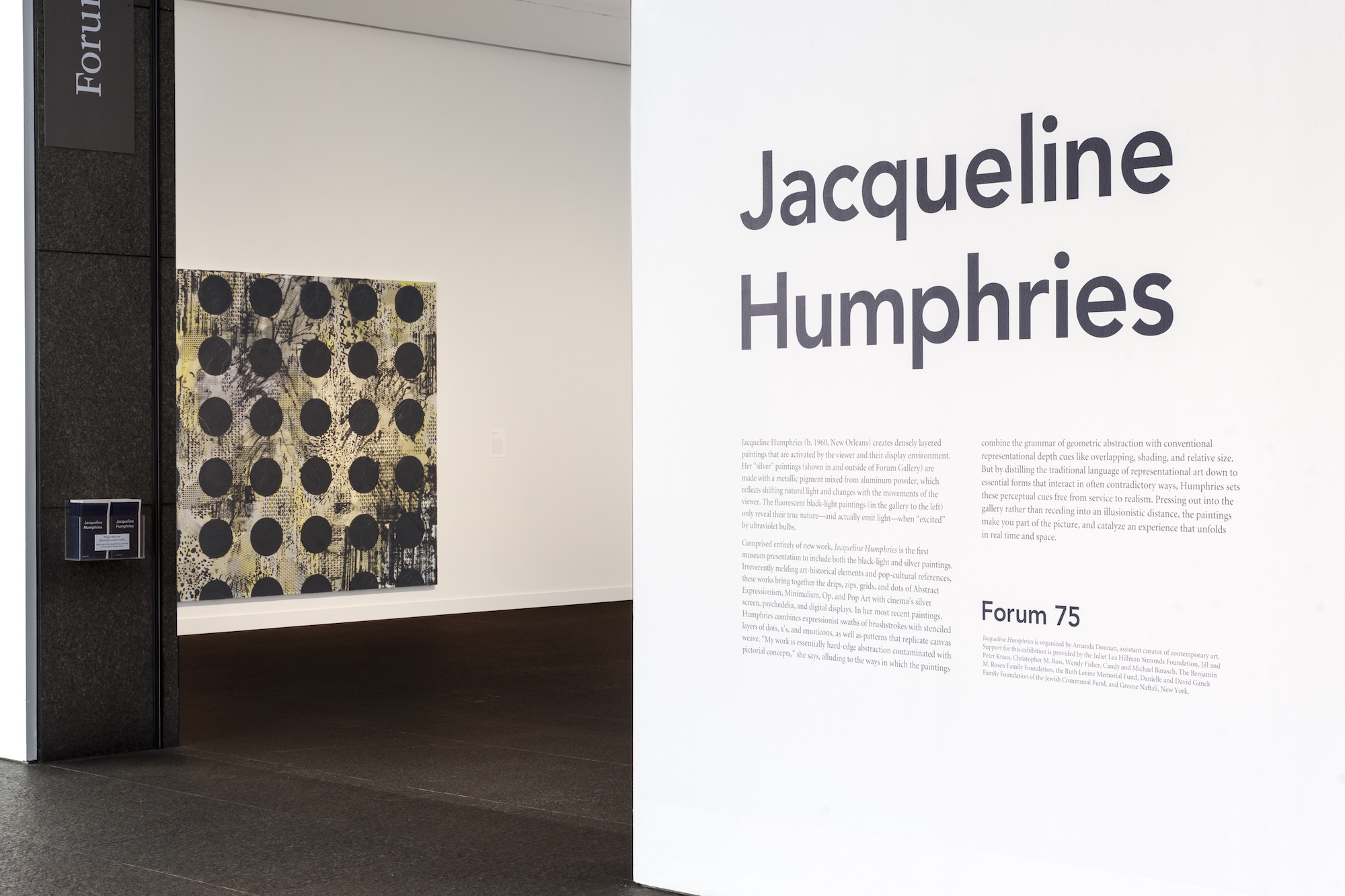Jacqueline Humphries
LEFT:
Jacqueline Humphries, Untitled, 2015, Enamel on linen [courtesy of the artist and Greene Naftali, New York] 114 x 127 inches
CENTER:
Jacqueline Humphries, Untitled, 2014, Enamel on linen [courtesy of the artist and Greene Naftali, New York] 114 x 127 inches
RIGHT:
Jacqueline Humphries, Untitled, 2014, Enamel on linen [courtesy of the artist and Green Naftali, New York] 114 x 127 inches
Share:
This interview was originally published in ART PAPERS March/April 2016, Vol. 40, issue 2.
What would it be like to ride a beam of light? Einstein raised that question in 1905 and arrived at an answer in the form of his Theory of Relativity, which forever altered the way space and time were perceived. In a nutshell, it all depends on perspective—where one stands. In 2005 a fire ravaged the studio of New Orleans-born, Brooklyn-based painter Jacqueline Humphries, a disaster that may appear fortunate when looked back upon from a certain perspective: the termination of one series allowed two new series to begin. She dates her stated desire to “create light”—pursued through recent paintings in her silver and black light series on view in Jacqueline Humphries (November 19, 2015–February 28, 2016)—from that destruction. Both the silver and black light series, exhibited together at the Contemporary Arts Center in New Orleans, pose questions about the nature of time, space, and light, and our past and present views of these things with regard to visual art. What Humphries’ work suggests is that if light, as Einstein argued, is a coded representation of something else—the eye’s peculiar interpretation of energy—then perhaps a more vitalistic, or even animistic, approach to image-making might provide the most incisive, energetic way for an artist to engage with the world.
Jacqueline Humphries, installation view, 2015 [photo: Bryan Conley; courtesy of the artist and Greene Naftali and Carnegie Museum of Art, New York]
Initially, Humphries’ shimmering silver paintings—which suggest halftone dots, and contain protean forms that shift or elude the eye depending on the angle of view—recall the gritty but glittering pop epoch of Andy Warhol’s Index Book (circa 1967), whose metallic silver covers and contrasty halftone graphics encapsulate the early Factory years. From a distance, Humphries’ works also suggest the grids of rivets on the vintage steel structures that dot America’s urban industrial landscape. Yet up close, many of them turn out to incorporate the emojis or emoticons that have become inescapable in the digital age. The silver paintings are created with intense pigments and machined stencils, yielding layered planes of gridded forms and expressionistic disturbances amid a metallic murk. As such, they visualize the paradoxes of the present moment: a time when most aspects of life rely on cybernetic systems that overlay the atavistic influence of disorderly human impulses, and the alluvial layers of history that make our cities the palimpsests that they are. Looking into a painting such as O (2015), or almost any of the adjacent works, with their studded grids and meandering mesh-like substrata of interstitial emoticons, can be akin to contemplating the accumulated paradoxes of visual culture itself. Each painting reflects the liminality of the present, when the concrete, the electronic, and the digital have merged to form a still-undefined, hybrid realm of human experience.
Humphries’ black light paintings are less industrial, and more carnivalesque than ones in her silver series, with flourishes that reflect her family history in the cultures of this city and of Sainte-Domingue, which her mother’s family fled in the latter 18th century to escape the turmoil of the Haitian revolution. We might not fully appreciate how radical the spontaneity of a Pollock or de Kooning looked in an era when that was unknown in Euro-American art, or how the stark, pulsating forms and colors of a Rothko or Motherwell must have seemed like pagan idols in the chapel of high art, before they became the chapel of high art. Humphries’ black light paintings revisit the ab-ex impulse, via pop art’s bastard child: the psychedelic graphics of the late 1960s Summer of Love. The results are immersive and wondrous. Suddenly, we are in the cave of the ancients, but the fires are cool, electronic, and the shimmering forms on the cavern walls evoke archetypes quite different from the bison of Lascaux. Both series are imbued with a motile inner light that defies reproduction, and both reflect a latter-day animist sensibility that suggests a fascination with the phenomenal, ever-shifting textures of life in the early 21st century—and a fascination with the challenging discipline of perception in this most ambiguous of times.
